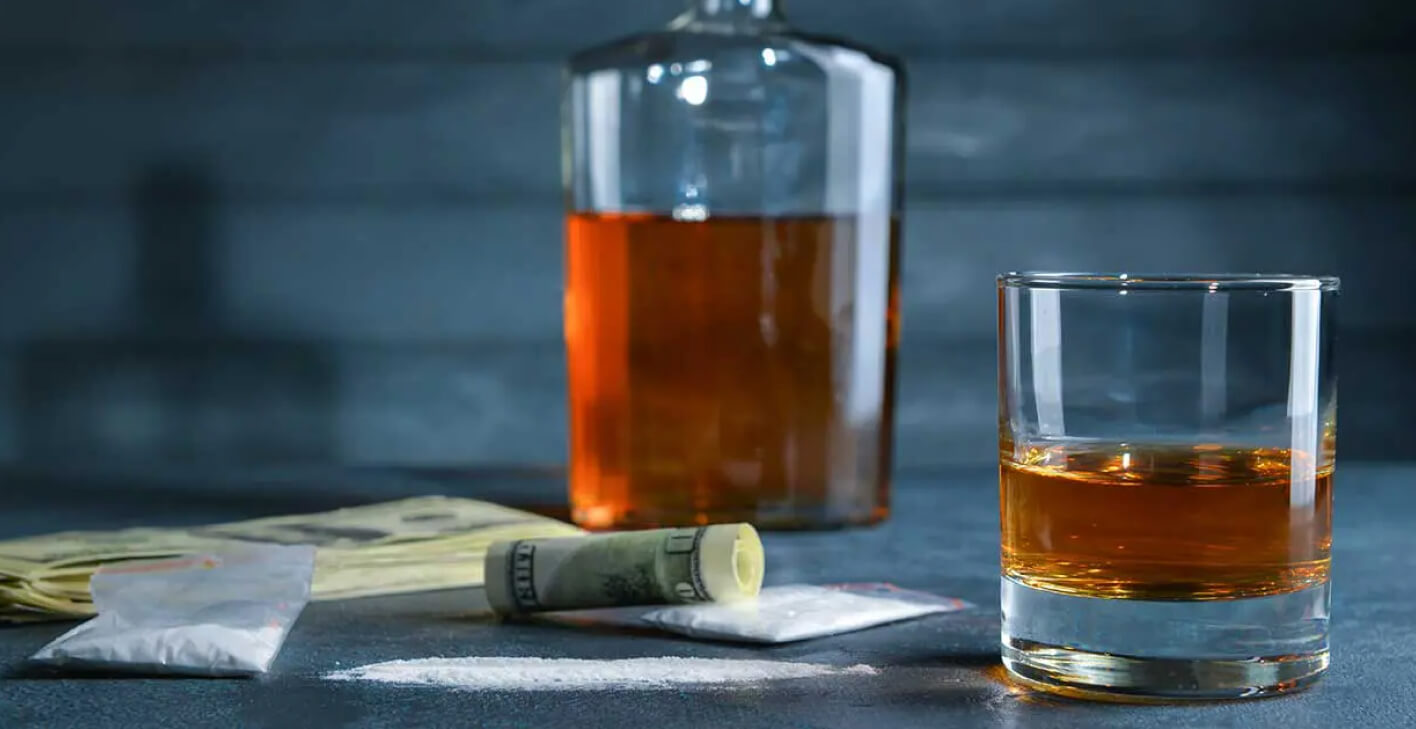The Dangers of Mixing Cocaine and Alcohol—What Happens When You Mix
Cocaine, commonly known as coke, is a potent and highly addictive drug by itself, but it’s often mixed with other substances.
Coke and alcohol are often mixed, which carries additional risks compared to other substances. Cocaine is a stimulant, while alcohol is a depressant – mixing the two can produce cardiotoxic effects and increase the risk of cardiac-related medical issues.[1]

Frequently Asked Questions
What Happens When You Mix Cocaine and Alcohol?
Some people mistakenly believe that mixing cocaine with alcohol will create milder or more balanced effects, but the result is often unpredictable and dangerous. The combination of cocaine and alcohol doesn’t cancel each other out but masks the effects, increasing the risk of alcohol poisoning, overdose, and other adverse effects.
Does Coke Sober You Up?
You may feel like cocaine sobers you up. However, it just makes you feel less drunk because it superficially counteracts the effects of alcohol intoxication, such as giving you alertness when you’d otherwise feel tired or slowed.[18] But legally, you’re no more sober than you were before, and you could miss some important indicators that you’ve taken too much of either substance.
Can You Put Cocaine in a Drink?
When injected, powder cocaine is dissolved into water to make it injectable. In the past, when cocaine was thought to be safe, it was found in regular products, including Coca-Cola’s original recipe.[19] So, cocaine can theoretically be dissolved into a drink, but that doesn’t mean it should be. Cocaine use isn’t safe in any amount or method of administration, least of all when mixed with alcoholic beverages – dissolved or otherwise.
Pergolizzi, J., Breve, F., Magnusson, P., LeQuang, J. a. K., & Varrassi, G. (2022). Cocaethylene: when cocaine and alcohol are taken together. Curēus. Retrieved from https://doi.org/10.7759/cureus.22498 on 2024, June 9.
U.S. Department of Health and Human Services. (n.d.). Alcohol policy. National Institute on Alcohol Abuse and Alcoholism. Retrieved from https://www.niaaa.nih.gov/alcohols-effects-health/alcohol-policy#:~:text=The%20Federal%20Uniform%20Drinking%20Age,State%20abides%20by%20that%20standard on 2023, July 9.
Substance abuse and mental health services administration. (n.d.). Retrieved from https://store.samhsa.gov/sites/default/files/pep21-06-02-002.pdf on 2023, July 9.
Pergolizzi, J., Breve, F., Magnusson, P., LeQuang, J. A. K., & Varrassi, G. (2022, February 22). Cocaethylene: When cocaine and alcohol are taken together. Cureus. Retrieved from https://www.ncbi.nlm.nih.gov/pmc/articles/PMC8956485/ on 2023, July 9.
Pergolizzi, J., Breve, F., Magnusson, P., LeQuang, J. A. K., & Varrassi, G. (2022, February 22). Cocaethylene: When cocaine and alcohol are taken together. Cureus. Retrieved from https://www.ncbi.nlm.nih.gov/pmc/articles/PMC8956485/ on 2023, July 9.
Pergolizzi, J., Breve, F., Magnusson, P., LeQuang, J. A. K., & Varrassi, G. (2022, February 22). Cocaethylene: When cocaine and alcohol are taken together. Cureus. Retrieved from https://www.ncbi.nlm.nih.gov/pmc/articles/PMC8956485/ on 2023, July 9.
Pergolizzi, J., Breve, F., Magnusson, P., LeQuang, J. A. K., & Varrassi, G. (2022, February 22). Cocaethylene: When cocaine and alcohol are taken together. Cureus. Retrieved from https://www.ncbi.nlm.nih.gov/pmc/articles/PMC8956485/ on 2023, July 9.
Dangers of mixing students also use the drug at social events … (n.d.-a). Retrieved from https://eloncdn.blob.core.windows.net/eu3/sites/605/2018/03/Mixing-Alcohol-with-Prescription-Med-2.pdf on 2023, July 9.
Dangers of mixing students also use the drug at social events … (n.d.-a). Retrieved from https://eloncdn.blob.core.windows.net/eu3/sites/605/2018/03/Mixing-Alcohol-with-Prescription-Med-2.pdf on 2023, July 9.
Dangers of mixing students also use the drug at social events … (n.d.-a). Retrieved from https://eloncdn.blob.core.windows.net/eu3/sites/605/2018/03/Mixing-Alcohol-with-Prescription-Med-2.pdf on 2023, July 9.
Alcohol and cocaine use prior to suspected suicide: Insights from … (n.d.-a). Retrieved from https://onlinelibrary.wiley.com/doi/full/10.1111/dar.13260 on 2023, July 9.
U.S. Department of Health and Human Services. (n.d.-b). Understanding alcohol use disorder. National Institute on Alcohol Abuse and Alcoholism. Retrieved from https://www.niaaa.nih.gov/publications/brochures-and-fact-sheets/understanding-alcohol-use-disorder on 2023, July 9.
Chapter 3—medical aspects of stimulant use disorders. (n.d.-b). Retrieved from https://www.ncbi.nlm.nih.gov/books/NBK576550/ on 2023, July 9.
Polysubstance use disorder – what you need to know. Drugs.com. (n.d.). Retrieved from https://www.drugs.com/cg/polysubstance-use-disorder.html on 2023, July 9.
What is a substance use disorder?. Psychiatry.org – What Is a Substance Use Disorder? (n.d.). Retrieved from https://www.psychiatry.org/patients-families/addiction-substance-use-disorders/what-is-a-substance-use-disorder on 2023, July 9.
Trevisan, L. A., Boutros, N., Petrakis, I. L., & Krystal, J. H. (1998). Complications of alcohol withdrawal: Pathophysiological insights. PubMed Central (PMC). Retrieved from https://www.ncbi.nlm.nih.gov/pmc/articles/PMC6761825/ on 2024, June 9.
U.S. Department of Health and Human Services. (n.d.). Substance use and co-occurring mental disorders. National Institute of Mental Health. Retrieved from https://www.nimh.nih.gov/health/topics/substance-use-and-mental-health#:~:text=Substance%20use%20disorder%20(SUD)%20is,most%20severe%20form%20of%20SUD on 2023, July 9.
Farré M;de la Torre R;González ML;Terán MT;Roset PN;Menoyo E;Camí J; (n.d.). Cocaine and alcohol interactions in humans: Neuroendocrine effects and cocaethylene metabolism. The Journal of pharmacology and experimental therapeutics. Retrieved from https://pubmed.ncbi.nlm.nih.gov/9336321/ on 2023, July 9.
Did Coca-Cola ever contain cocaine?. Did Coca-Cola Ever Contain Cocaine? | Just Think Twice. (n.d.). Retrieved from https://www.justthinktwice.gov/article/did-coca-cola-ever-contain-cocaine on 2023, July 9.